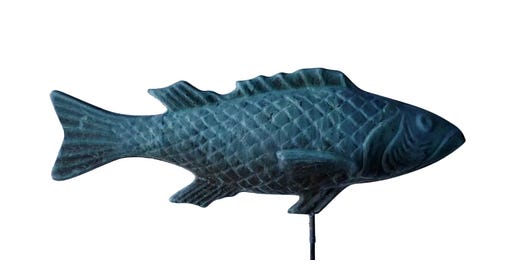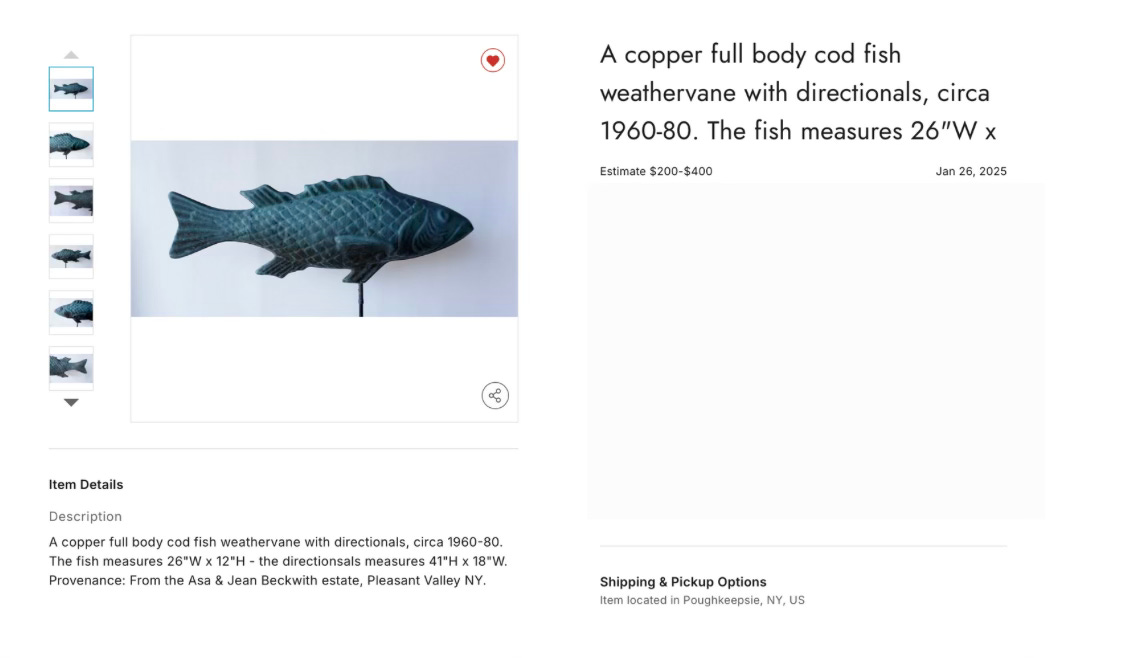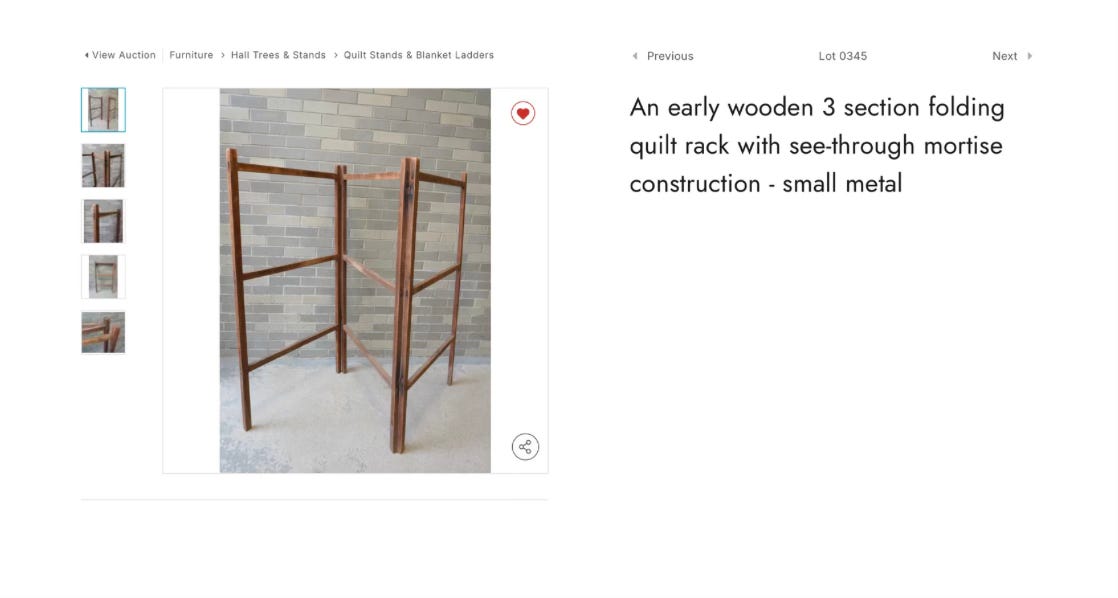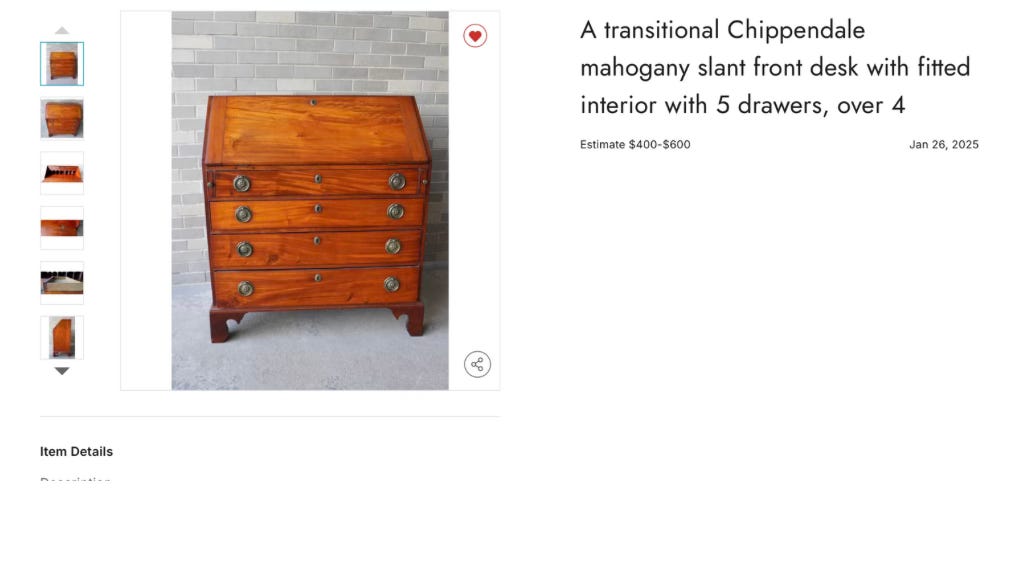Auction Finds: Folk Art & Functional Furniture
from secret book boxes to clever furniture: six pieces that caught my eye
One corner of the internet that never disappoints me is online auctions. My favorite way to relax at night is to click through their previews. There's a sense of possibility in each new catalog - what might appear on the next page? Like browsing library stacks or a good bookstore, I find the serendipity and juxtaposition of lots deeply satisfying. Some of my fondest memories from graduate school are visiting auction previews with my professors, handling pieces, and learning their histories.
Welcome to another edition of Auction Finds, your insider view of what's coming up at auction. As with all posts in this series, every piece featured is currently available for bidding, and I schedule this section so you can participate if something speaks to you. After the auction closes, I'll update with the final selling prices. Following auction results has been one of my best teachers. I share these time-sensitive finds exclusively with paid subscribers as a tangible thank you for your support - your subscription makes this newsletter possible.
Here are six items from Hyde Park Country Auctions' January 26, 2025 sale. The auctioneer, Dom, is one of my favorite sources - his showroom in a sleepy Hyde Park, NY strip mall is truly like Aladdin's cave. He consistently offers high-quality Americana and folk art pieces at surprisingly accessible prices.
Folk Art Finds:
The folk art wooden book: This is a fascinating 19th-century folk art piece - a wooden box cleverly disguised as a book. The craftsmanship is quite remarkable, featuring extensive geometric inlay work. What makes this piece particularly impressive is its secret compartment mechanism: the "book" has a hidden drawer that opens through an ingenious two-step process. First, you pull down the spine, which releases a locking mechanism, and then you pull forward on what looks like a decorative lock on the front cover (which actually serves as the drawer pull). My kids love secret hiding places, and this would be a fun activity for a coffee table. Sold for $200.
Cod weathervane: I've completely fallen for this fish weathervane - look at that gorgeous blue-green patina that only comes from decades of wind and weather! Those meticulously hammered scales create a diamond pattern across its body, and the whimsical yet determined expression on its face marks it as a lovely piece of folk art. Someone spent real time getting those details just right. I love imagining all the storms it weathered to develop that perfect verdigris finish. Sold for $125.
Practical Poetry / Functional Furniture:
Folding quilt rack: This is the 19th-century version of the drying rack I used in NYC (few of my apartments ever had a washer/dryer)! What I love about this rack is how it served multiple purposes - yes, it was practical for airing out quilts and blankets (imagine the fresh smell after a day in the breeze). Still, the rack also is an impromptu display, showing off the handwork of family quilts. The beautiful mortise and tenon joinery means each piece fits together like a puzzle. This is the kind of object that is still as useful today as it was a 100 years ago - whether for a spot for throws and blankets in a TV room or just airing out your comforter. And when folded, it can easily slip behind a door or into a corner - proof that good design is timeless! Sold for $70.
Washstand: I have such a soft spot for these humble country washstands - they tell the real story about daily life before indoor plumbing. Every bedroom needed one for the morning ritual of washing up with a pitcher and basin. This one's from around 1830-50, made of poplar that's mellowed to this gorgeous honey color. While it's a relatively simple piece, whoever made it couldn't resist adding some flourishes - look at that shaped gallery (that's design-speak for the backboard) with a decorative cut-out! The solid dovetailed joints have held for nearly 200 years. I love the two-tier design - the top surface for your basin and maybe some soap, and the lower shelf probably held extra towels or your chamber pot. Those turned legs give it such nice proportions - clearly made by someone who cared about their craft, even for everyday furniture. I have one at the top of my stairs in an awkward nook where it acts as a plant stand and a catch-all for my teenager's used dishes! Sold for $100.
Two More Refined Furniture Pieces
Mahogany slant front desk: This desk has me thinking about how we've lost the ritual of letter writing. Imagine sitting down here, lifting that angled lid to reveal all those tiny cubbies and drawers inside (these desks are like the original organizational system - a place for everything!). Looking closely, you can see how the craftsperson chose pieces with beautiful grain patterns for the drawer fronts. They call this a 'transitional' piece because it mixes design elements from different periods - like someone familiar with Chippendale but putting their own spin on things. I particularly love those bracket feet - they give the whole piece a sense of movement, almost like it's doing a little dance despite being such a serious piece of furniture. This is the kind of desk that could work anywhere. Imagine how satisfying it would be to sit down here to write thank you notes or catch up on correspondence, or, let's be honest, answer emails on your laptop! Sold for $400.
Sheraton drop leaf table: This table would be perfect in so many spots - as a console in an entry that could expand for holiday buffets or even as a compact work-from-home setup that could hide away when not in use. The wood has developed that gorgeous patina from years of use. I wasn't familiar with the term' harvest table' and did some research - this would have been used for communal gatherings, which adds to its charm. This is precisely the kind of piece I love finding at auction - beautiful craftsmanship, practical design, and a price that makes collecting antiques feel possible. Sold for $100.
Next month, I'll be back with another subscriber-only auction preview because great design is everywhere. Until then, here's to keeping our eyes open and our sense of wonder intact. P.S. Hit that reply button and tell me which piece spoke to you most. I'm always eager to hear your stories and perspectives!
An Experiment for Subscribers-Only
I've created a Google Calendar just for subscribers - once you add the calendar you should be able to add a reminder about this auction starting to your personal calendar. This is an experiment—if something about the calendar doesn't work for you, please let me know so I can refine it!
A Quick and Dirty Auctions 101
If any of these pieces have caught your eye, now's the time to do your homework. If you haven't already, you'll need to create an account with Hyde Park Country Auctions and be verified to bid (typically, this is just providing a credit card). Then, request those condition reports, calculate your total budget (don't forget those buyer's premiums!), and most importantly - have fun with it.
About object condition: While I've looked carefully at the online photos, I always recommend requesting a detailed condition report from the auction house before bidding.
About buyer's premiums: Remember to factor in the auction house fee! When deciding my maximum bid, I always include this in my mental math—these premiums can add up!
Shipping antiques can be complex and expensive. It often requires you to source a shipper with whom you'll need to communicate beforehand and pay separately. Of course, you'll need to factor these costs into your budget (or plan to pick up your win in person if you're local).
If you're new to auctions, I suggest starting small! The whole process has a learning curve, from requesting condition reports to understanding buyer's premiums to arranging shipping. Think of it like learning to swim—start in the shallow end before diving into the deep end with larger pieces.











